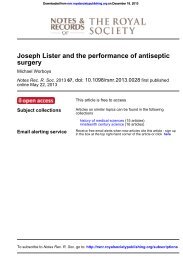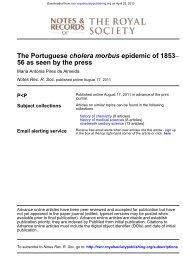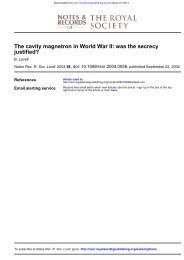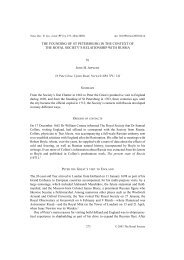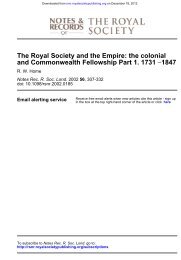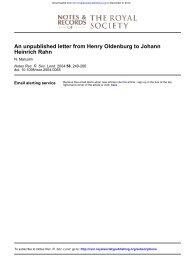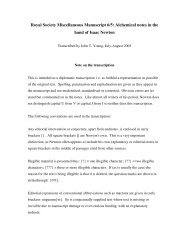Jarrow, Co. Kilkenny - Notes and Records of the Royal Society
Jarrow, Co. Kilkenny - Notes and Records of the Royal Society
Jarrow, Co. Kilkenny - Notes and Records of the Royal Society
Create successful ePaper yourself
Turn your PDF publications into a flip-book with our unique Google optimized e-Paper software.
Downloaded from<br />
rsnr.royalsocietypublishing.org on March 23, 2013<br />
History <strong>of</strong> <strong>the</strong> <strong>Jarrow</strong> fossil vertebrates 3<br />
FINDERS NOT ALWAYS KEEPERS<br />
The Dublin scientific community first became aware <strong>of</strong> <strong>the</strong> existence <strong>of</strong> fossils in <strong>the</strong> <strong>Jarrow</strong><br />
colliery when William Bookey Brownrigg (ca. 1843–1906) announced to a <strong>Co</strong>uncil Meeting<br />
<strong>of</strong> <strong>the</strong> <strong>Royal</strong> Geological <strong>Society</strong> <strong>of</strong> Irel<strong>and</strong> 11 (RGSI) on 1 March 1865 that he intended to<br />
‘bring forward a paper on some fossils from <strong>the</strong> Leinster coalfield’. However, this <strong>of</strong>fer<br />
was conditional on that society’s funding <strong>the</strong> production <strong>and</strong> printing <strong>of</strong> plates that he<br />
wished to accompany <strong>the</strong> paper. This was agreed, 11 <strong>and</strong> Brownrigg read his paper on<br />
14 June 1865 to a meeting <strong>of</strong> <strong>the</strong> RGSI, 12 which was subsequently published in <strong>the</strong>ir<br />
journal. 13 Twenty members were present at <strong>the</strong> reading, <strong>and</strong> although Wright was a<br />
member he was not among <strong>the</strong>m. 14 This was followed by an oral presentation to <strong>the</strong> same<br />
society on 8 November 1865 by Henry Beresford de la Poer Wall, 15 a prize-winning<br />
science student <strong>of</strong> Trinity <strong>Co</strong>llege, Dublin, who hailed from <strong>the</strong> midl<strong>and</strong> town <strong>of</strong><br />
Portarlington. Wall also took <strong>the</strong> opportunity to exhibit to <strong>the</strong> assembly more fossils <strong>of</strong><br />
<strong>the</strong> same provenance. 16 Unfortunately Wall’s paper was not subsequently published. The<br />
appreciation <strong>of</strong> <strong>the</strong> RGSI meeting <strong>of</strong> Brownrigg’s contribution was wholesome <strong>and</strong><br />
undisputed, at both <strong>the</strong> 14 June <strong>and</strong> 8 November meetings, <strong>and</strong> it was clear that <strong>the</strong><br />
academic value <strong>of</strong> <strong>the</strong> fossils did not escape <strong>the</strong> assembly. A fur<strong>the</strong>r meeting, this time <strong>of</strong><br />
<strong>the</strong> RIA in Dawson Street, 17 was held on 8 January 1866. Between <strong>the</strong>se last two meetings<br />
an important <strong>and</strong> dramatic, but subtle, change had occurred, namely that Brownrigg’s<br />
initiative in <strong>the</strong> enterprise had been effectively taken away from him, behind a thick<br />
smokescreen <strong>of</strong> many good words from Wright <strong>and</strong> from Huxley. The audience heard a<br />
presentation by Dr E. P. Wright, written by himself <strong>and</strong> Pr<strong>of</strong>essor Thomas Henry Huxley,<br />
entitled ‘On <strong>the</strong> fossil remains <strong>of</strong> some large Batrachian reptiles from <strong>the</strong> Irish coal<br />
measures’. Here Wright mentioned W. B. Brownrigg Esq. <strong>of</strong> Brannockstown as having sighted<br />
traces <strong>of</strong> several vertebrate remains which struck him as new. ...These specimens he showed<br />
to several friends in Dublin who pronounced <strong>the</strong>m to be <strong>the</strong> remains <strong>of</strong> fish, <strong>and</strong> reptiles; <strong>and</strong> in<br />
<strong>the</strong> autumn <strong>of</strong> last year one <strong>of</strong> <strong>the</strong> authors <strong>of</strong> this paper paid two visits to <strong>the</strong> coal pit in<br />
company with Mr Brownrigg ...collecting a very valuable series <strong>of</strong> specimens .... 17<br />
William Bookey Brownrigg (figure 2) <strong>of</strong> Moor Hill, Brannockstown, <strong>Co</strong>. Kildare, was born in<br />
about 1834, <strong>the</strong> only son <strong>of</strong> William Brownrigg, a local l<strong>and</strong>owner <strong>and</strong> Justice <strong>of</strong> <strong>the</strong> Peace. He<br />
studied at Trinity <strong>Co</strong>llege, 18 Dublin, where he was a scholar in 1856, graduated BA in 1859 <strong>and</strong><br />
was registered as a University Elector on 27 October 1860. Thus he was a contemporary <strong>of</strong><br />
Edward Perceval Wright, whom he knew when <strong>the</strong>y were both students in Trinity. While still<br />
a student, Brownrigg demonstrated his scientific interests by having a paper published on <strong>the</strong><br />
wood-boring shipworm Teredo norvegica that he had discovered at Tramore,<br />
<strong>Co</strong>. Waterford. 19 Although he was a l<strong>and</strong>owner in <strong>Co</strong>. Kildare he also had an estate <strong>of</strong> 596<br />
acres near <strong>Kilkenny</strong>, 20 <strong>and</strong> like o<strong>the</strong>rs <strong>of</strong> his social st<strong>and</strong>ing he also maintained a Dublin<br />
home, at 18 Adelaide Road, from where he wrote to Huxley (see below).<br />
On 11 January 1860 Brownrigg was elected an Associate Member <strong>of</strong> <strong>the</strong> Geological<br />
<strong>Society</strong> <strong>of</strong> Dublin (GSD) <strong>and</strong> only four months later read his first paper to <strong>the</strong> society, 21<br />
describing <strong>the</strong> geological structure near Dungarvan, <strong>Co</strong>. Waterford; <strong>the</strong> paper was coauthored<br />
22 with Theodore <strong>Co</strong>oke (1836–1910). <strong>Co</strong>oke later became a renowned botanist<br />
in India. 23 On 12 December 1861 Brownrigg was elected a Fellow <strong>of</strong> <strong>the</strong> GSD, 24 having<br />
been proposed by R. H. Scott <strong>and</strong> seconded by E. P. Wright. Shortly afterwards, on<br />
11 February 1863, he was elected an ordinary member <strong>of</strong> <strong>the</strong> society’s <strong>Co</strong>uncil <strong>and</strong>



